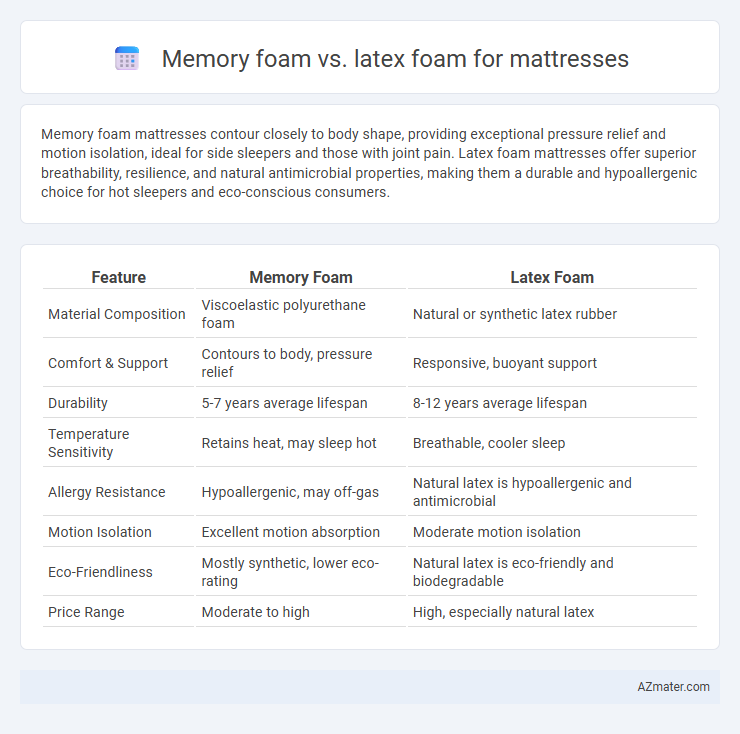Memory foam mattresses contour closely to body shape, providing exceptional pressure relief and motion isolation, ideal for side sleepers and those with joint pain. Latex foam mattresses offer superior breathability, resilience, and natural antimicrobial properties, making them a durable and hypoallergenic choice for hot sleepers and eco-conscious consumers.
Table of Comparison
| Feature | Memory Foam | Latex Foam |
|---|---|---|
| Material Composition | Viscoelastic polyurethane foam | Natural or synthetic latex rubber |
| Comfort & Support | Contours to body, pressure relief | Responsive, buoyant support |
| Durability | 5-7 years average lifespan | 8-12 years average lifespan |
| Temperature Sensitivity | Retains heat, may sleep hot | Breathable, cooler sleep |
| Allergy Resistance | Hypoallergenic, may off-gas | Natural latex is hypoallergenic and antimicrobial |
| Motion Isolation | Excellent motion absorption | Moderate motion isolation |
| Eco-Friendliness | Mostly synthetic, lower eco-rating | Natural latex is eco-friendly and biodegradable |
| Price Range | Moderate to high | High, especially natural latex |
Introduction: Memory Foam vs Latex Foam
Memory foam mattresses contour to the body by responding to heat and pressure, offering excellent support and pressure relief for side and back sleepers. Latex foam mattresses provide a resilient, breathable surface with natural hypoallergenic and antimicrobial properties, ideal for those seeking a cooler sleep environment. Both materials vary in durability, firmness options, and natural composition, influencing comfort and sleep quality.
Material Composition and Structure
Memory foam mattresses consist of viscoelastic polyurethane, which responds to body heat and pressure by contouring closely to the sleeper, providing pressure relief and motion isolation. Latex foam mattresses are made from natural or synthetic latex derived from rubber tree sap, featuring an open-cell structure that offers more bounce, durability, and breathability compared to memory foam. The distinct cellular structures influence airflow and support, with memory foam being denser and slower to respond, while latex foam is more resilient and responsive.
Comfort and Support Comparison
Memory foam mattresses provide excellent body contouring and pressure relief by adapting to individual body shapes, making them ideal for side sleepers and those with joint pain. Latex foam offers superior bounce and responsiveness with consistent support, promoting better spinal alignment and breathability due to its natural open-cell structure. Both materials vary in durability and firmness options, but memory foam generally excels in comfort while latex foam stands out for support and temperature regulation.
Pressure Relief and Spinal Alignment
Memory foam mattress offers superior pressure relief by contouring closely to the body's curves, reducing stress on joints and promoting even weight distribution. Latex foam provides firm yet responsive support, maintaining natural spinal alignment by preventing excessive sinking and encouraging proper posture throughout the night. Both materials excel in pressure relief and spinal support, but memory foam is often preferred for cushioning, while latex is favored for its durability and resilience.
Temperature Regulation and Breathability
Memory foam tends to retain heat due to its dense structure, often leading to less effective temperature regulation and reduced breathability compared to latex foam. Latex foam features an open-cell design and natural ventilation properties, promoting superior airflow and cooler sleeping conditions. For individuals seeking enhanced temperature regulation and breathability, latex foam mattresses are generally the preferred choice.
Durability and Lifespan
Memory foam mattresses typically offer a lifespan of 7 to 10 years, while latex foam mattresses can last between 12 to 15 years due to their natural resilience. Durability in latex foam is enhanced by its resistance to sagging and indentation, maintaining support over time. Memory foam tends to soften with extended use, potentially reducing overall support and comfort faster than latex foam options.
Motion Isolation and Noise
Memory foam mattresses provide superior motion isolation by contouring closely to the body and absorbing movement, making them ideal for couples or light sleepers. Latex foam offers moderate motion isolation but excels in responsiveness and durability, creating less motion transfer compared to innerspring mattresses but more than memory foam. Noise generation is minimal for both materials since they are naturally sound-absorbing, with latex foam being entirely noiseless, while memory foam may occasionally produce slight creaking depending on density and cover.
Allergy and Eco-Friendliness
Latex foam mattresses are naturally hypoallergenic and resistant to dust mites and mold, making them an excellent choice for allergy sufferers, while memory foam, often synthetic, may emit volatile organic compounds (VOCs) that could trigger sensitivities. Eco-friendliness favors natural latex derived from rubber trees, which is biodegradable and sustainably harvested, contrasting with memory foam's petroleum-based composition that poses environmental challenges. Choosing organic or natural latex ensures reduced chemical exposure and a smaller ecological footprint, aligning with health-conscious and environmentally aware consumer preferences.
Price and Value for Money
Memory foam mattresses generally offer a more affordable price point compared to latex foam, making them a popular choice for budget-conscious buyers seeking pressure relief and contouring comfort. Latex foam mattresses, while typically more expensive due to natural materials and durability, provide superior longevity and hypoallergenic benefits, resulting in better long-term value for money. Evaluating mattress lifespan and material performance alongside initial cost helps determine the optimal investment based on personalized comfort and budget priorities.
Choosing the Right Mattress for Your Needs
Memory foam mattresses conform closely to your body, providing pressure relief and motion isolation ideal for side sleepers and those with joint pain. Latex foam offers responsive support and durability, promoting better airflow and a cooler sleep surface, making it suitable for hot sleepers and individuals seeking natural materials. Selecting the right mattress depends on personal preferences for firmness, temperature regulation, and any allergies, ensuring optimal comfort and support tailored to your sleeping habits.

Infographic: Memory foam vs Latex foam for Mattress
 azmater.com
azmater.com